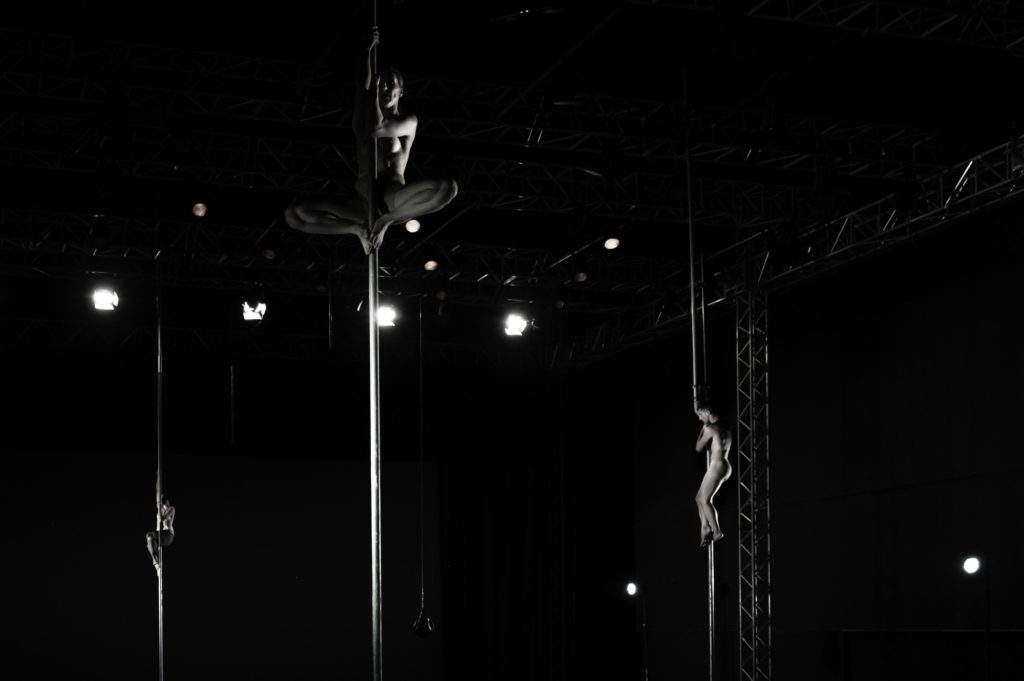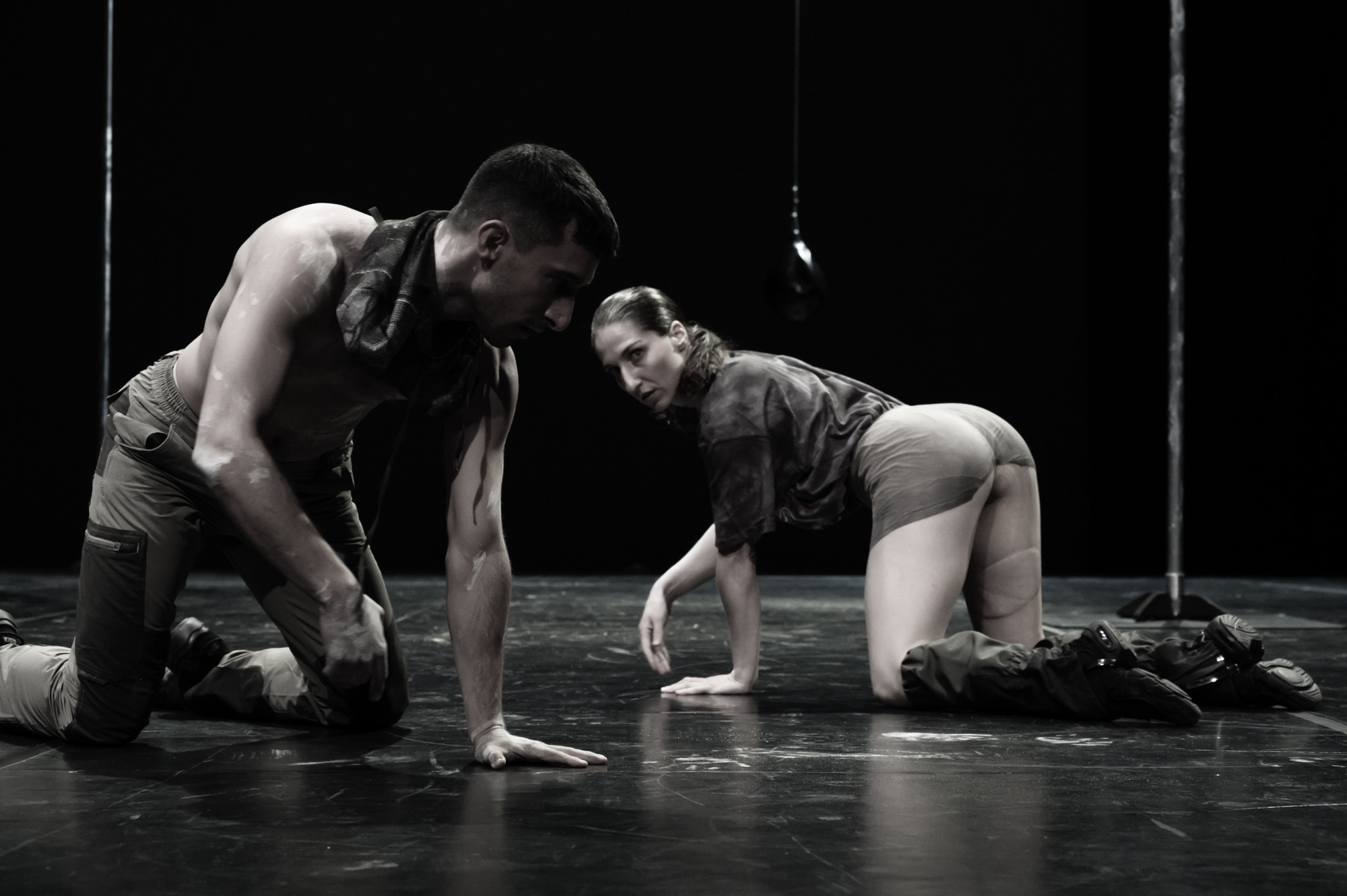Words by Giordana Patumi.
Lenio Kaklea is a Paris-based choreographer, dancer, and writer of Greek origin. Known for her bold exploration of contemporary themes through the language of dance, Kaklea’s works often delve into social, cultural and feminist topics, challenging audiences to rethink the conventions of movement and identity.
She studied at the National Conservatory of Contemporary Dance in Athens and further developed her practice at the Centre National de Danse Contemporaine in Angers, France. Over the years, she has collaborated with several prominent figures in the dance world, including François Chaignaud, Boris Charmatz, and Fanny de Chaillé. Her works have been performed across Europe and internationally, earning her a reputation as a daring and thought-provoking artist.
I had the chance to talk with her about one of her latest piece, Agrimi (Fauve) which I had the opportunity to watch in Zürich, Switzerland on September 1st, 2024, at Zürcher Theater Spektakel.
This piece explores new thematic territories for Lenio Kaklea, focusing on the complex relationship between humans and nature and is set to make its UK premiere at Sadler’s Wells, Lilian Baylis Studio, London on October & 1 November 2024 presented by Serpentine in partnership with Sadler’s Wells.
Giordana: Can you tell us about the central themes you’re exploring in Agrimi (Fauve) and the structure of the piece?
Lenio Kaklea: In Agrimi (Fauve) I wanted to explore the complexities of human relationships with nature, particularly the contradictory feelings of violence and affection we often display towards it. This work is structured in three acts, each of which draws on different sources and inspirations to create a cohesive narrative and choreographic experience.
The first act is set on the frontier of the forest, where the dancers engage in a sequence that draws heavily from pop culture. I was inspired by the movements of Beyoncé and Britney Spears, specifically how they embody animalistic qualities to convey themes of seduction and sexuality. This act uses these choreographed movements to explore human interaction with nature in a way that is both familiar and estranged from reality.
The second act transitions us into the forest itself. This is where the thematic core of the piece lies, focusing on the ambiguity and tension between violence and affection. I incorporated a text narrated by French antropologist Charles Stepanoff, which speaks about indigenous Siberian hunting rituals. This narrative provides a deeper reflection on how humans negotiate their presence in natural environments, balancing between domination and respect.
The third act serves as a culmination, where a ritualistic rewilding is performed. This is less about returning to nature in a literal sense and more about embodying the tensions and conflicts present in our relationship with the natural world. The dancers perform a highly physical, almost primal sequence on poles, symbolizing both the industrial and organic elements of our environment.
Giordana: You mentioned earlier your previous works were more focused on feminist theory and pop culture. How does Agrimi (Fauve) connect to or diverge from your earlier themes?
Lenio Kaklea: Pop culture remains a significant element in my work. Even in Agrimi (Fauve), pop culture is not something I’ve left behind; rather, it’s evolved. For example, the choreography in the first act is directly inspired by pop cultural figures. I chose this route to highlight how these figures shape our perceptions of the body, movement, and even our understanding of nature.
While my earlier works, such as Margin, were explicitly feminist and autobiographical, addressing the treatment and representation of female bodies, Agrimi (Fauve) shifts focus. Here, I wanted to explore ecological themes without abandoning my critical stance or my interest in popular cultural expressions. The piece remains informed by feminist thought, but it does so in a way that is less direct, more embedded in the fabric of the performance and the narratives it weaves.

Giordana: Can you elaborate on the visual and set design aspects of the performance? How did you approach creating the forest on stage?
Lenio Kaklea: The set design, created in collaboration with Clio Boboti, plays a crucial role in transforming the stage into a hybrid space that evokes both industrial and organic elements. We didn’t want to bring literal elements from the forest onto the stage—firstly, for logistical reasons, but more importantly, to challenge the audience’s imagination. Instead, we utilised elements typical of theatrical spaces to evoke the essence of a forest. For instance, poles used in the third act are both industrial, like something you might find in an urban environment or in the theatrical space, and yet they suggest trees, creating a sort of uncanny space that is neither fully natural nor artificial.
Giordana: Your work often involves collaboration. Who were some key collaborators for this piece, and how did they influence its development?
Lenio Kaklea: I have been fortunate to work with some incredibly talented individuals on Agrimi (Fauve). Éric Yvelin contributed significantly with his sound design, video, and technical direction, helping to shape the auditory and visual atmosphere of the piece. Bruno Pocheron’s lighting design also played a pivotal role in creating the shifting moods of the forest, from the stark, almost clinical brightness of the frontier to the shadowy, enigmatic depths of the forest. Lou Forster, our dramaturg and researcher, has been a vital part of the creative process. His work, particularly in editing the Nivkh tale we included in the performance, helped frame the narrative and provided a bridge between the choreography and the themes we wanted to explore. And, of course, the dancers—Georgios Kotsifakis, Ioanna Paraskevopoulou, and myself—were instrumental in bringing these ideas to life through their dedication and embodiment of the work.
Giordana: What do you hope audiences take away from Agrimi (Fauve)?
Lenio Kaklea: I hope the audience remains open to the strangeness of the piece. Agrimi (Fauve) isn’t a conventional work—it’s a space for reflection, for encountering familiar and unfamiliar elements in unexpected ways. I want people to think about how we interact with nature, how our cultural practices—be they pop, indigenous, or otherwise—shape and are shaped by our environments. I hope it sparks curiosity, provokes thought, and invites a kind of openness to the complexities and contradictions inherent in our world.
Giordana: Would you like to add anything else? An invitation or reflection perhaps?
Lenio Kaklea: I think it’s important to defend non-conventional approaches to art and performance. Creating art is a process and each piece represents a moment in an artist’s journey. Financial conditions often make it challenging to follow an artist’s work over the years, as few pieces get to tour internationally. Consequently, audiences may only see glimpses of an artist’s evolving path. I hope that people appreciate the context in which these works are made and understand that each piece contributes to a larger conversation and trajectory.
Having seen the performance myself, I can attest to the evocative power of Lenio Kaklea’s work. I encourage the UK audience to experience Agrimi (Fauve) and immerse themselves in this unique exploration of dance and our evolving relationship with nature.
The UK premiere of Agrimi (Fauve) is presented by Serpentine in partnership with Sadler’s Wells from 31 October to 1st November.
